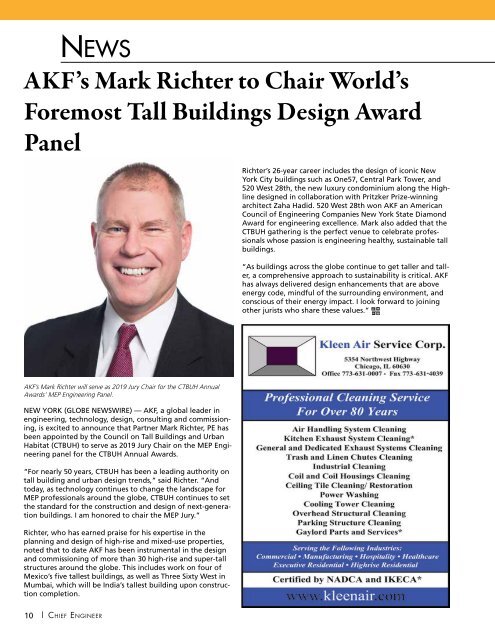Create successful ePaper yourself
Turn your PDF publications into a flip-book with our unique Google optimized e-Paper software.
NEWS<br />
AKF’s Mark Richter to Chair World’s<br />
Foremost Tall Buildings Design Award<br />
Panel<br />
Hidden Emergency Lighting Preserves<br />
Building Aesthetics While Meeting Code<br />
Richter’s 26-year career includes the design of iconic New<br />
York City buildings such as One57, Central Park Tower, and<br />
520 West 28th, the new luxury condominium along the Highline<br />
designed in collaboration with Pritzker Prize-winning<br />
architect Zaha Hadid. 520 West 28th won AKF an American<br />
Council of Engineering Companies New York State Diamond<br />
Award for engineering excellence. Mark also added that the<br />
CTBUH gathering is the perfect venue to celebrate professionals<br />
whose passion is engineering healthy, sustainable tall<br />
buildings.<br />
“As buildings across the globe continue to get taller and taller,<br />
a comprehensive approach to sustainability is critical. AKF<br />
has always delivered design enhancements that are above<br />
energy code, mindful of the surrounding environment, and<br />
conscious of their energy impact. I look forward to joining<br />
other jurists who share these values.”<br />
AKF’s Mark Richter will serve as 2019 Jury Chair for the CTBUH Annual<br />
Awards’ MEP Engineering Panel.<br />
NEW YORK (GLOBE NEWSWIRE) — AKF, a global leader in<br />
engineering, technology, design, consulting and commissioning,<br />
is excited to announce that Partner Mark Richter, PE has<br />
been appointed by the Council on Tall Buildings and Urban<br />
Habitat (CTBUH) to serve as 2019 Jury Chair on the MEP Engineering<br />
panel for the CTBUH Annual Awards.<br />
“For nearly 50 years, CTBUH has been a leading authority on<br />
tall building and urban design trends,” said Richter. “And<br />
today, as technology continues to change the landscape for<br />
MEP professionals around the globe, CTBUH continues to set<br />
the standard for the construction and design of next-generation<br />
buildings. I am honored to chair the MEP Jury.”<br />
Richter, who has earned praise for his expertise in the<br />
planning and design of high-rise and mixed-use properties,<br />
noted that to date AKF has been instrumental in the design<br />
and commissioning of more than 30 high-rise and super-tall<br />
structures around the globe. This includes work on four of<br />
Mexico’s five tallest buildings, as well as Three Sixty West in<br />
Mumbai, which will be India’s tallest building upon construction<br />
completion.<br />
Many of Isolite’s architectural emergency lighting solutions are virtually invisible during normal lighting conditions, eliminating unattractive surface mounted<br />
emergency lights.<br />
While emergency lighting is critical to life safety and must<br />
function to code, no one wants to see the devices ruin the<br />
aesthetics of a building’s interiors. So industry professionals<br />
are increasingly keeping the lights hidden or camouflaged<br />
until needed to ensure it artfully blends in with its surroundings.<br />
“From the standpoint of interior architectural aesthetics, traditional<br />
wall or ceiling-mounted emergency lighting systems<br />
can be sort of an eyesore that establishments with a more<br />
refined look want to eliminate because it can take away<br />
from the architectural experience,” says John Decker, IALD of<br />
Lighting Design Studio, a multi-disciplinary firm. The company<br />
has completed lighting projects for a variety of commercial<br />
spaces including resort hotels, spas, casinos, restaurants,<br />
retail, and office spaces.<br />
Now an innovative option, fixtures completely hidden<br />
behind closed-door panels on walls or ceilings, is helping to<br />
meet emergency lighting code. Only in the case of emergency<br />
or power outage do the doors open and the emergency<br />
lights emerge to ensure sufficient light along the path of<br />
egress, as mandated by the NFPA and International Building<br />
Code (IBC). For even greater discretion, the panels can be<br />
painted, wallpapered over, and placed in locations out of the<br />
line of sight to make them completely inconspicuous.<br />
Enhancing Aesthetics and Ensuring Safety<br />
Design professionals often meticulously plan the aesthetics<br />
of various building elements including style, form, and ma-<br />
(Continued on page <strong>12</strong>)<br />
10 | Chief Engineer<br />
Volume 83 · Number <strong>12</strong> | 11


















